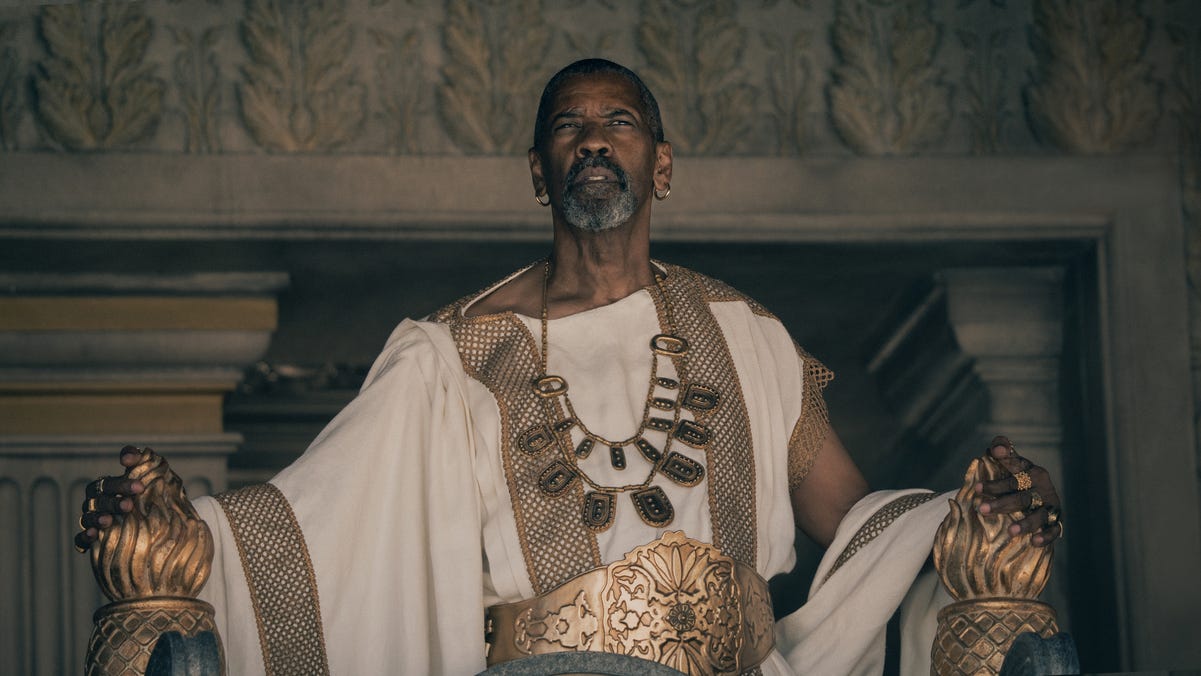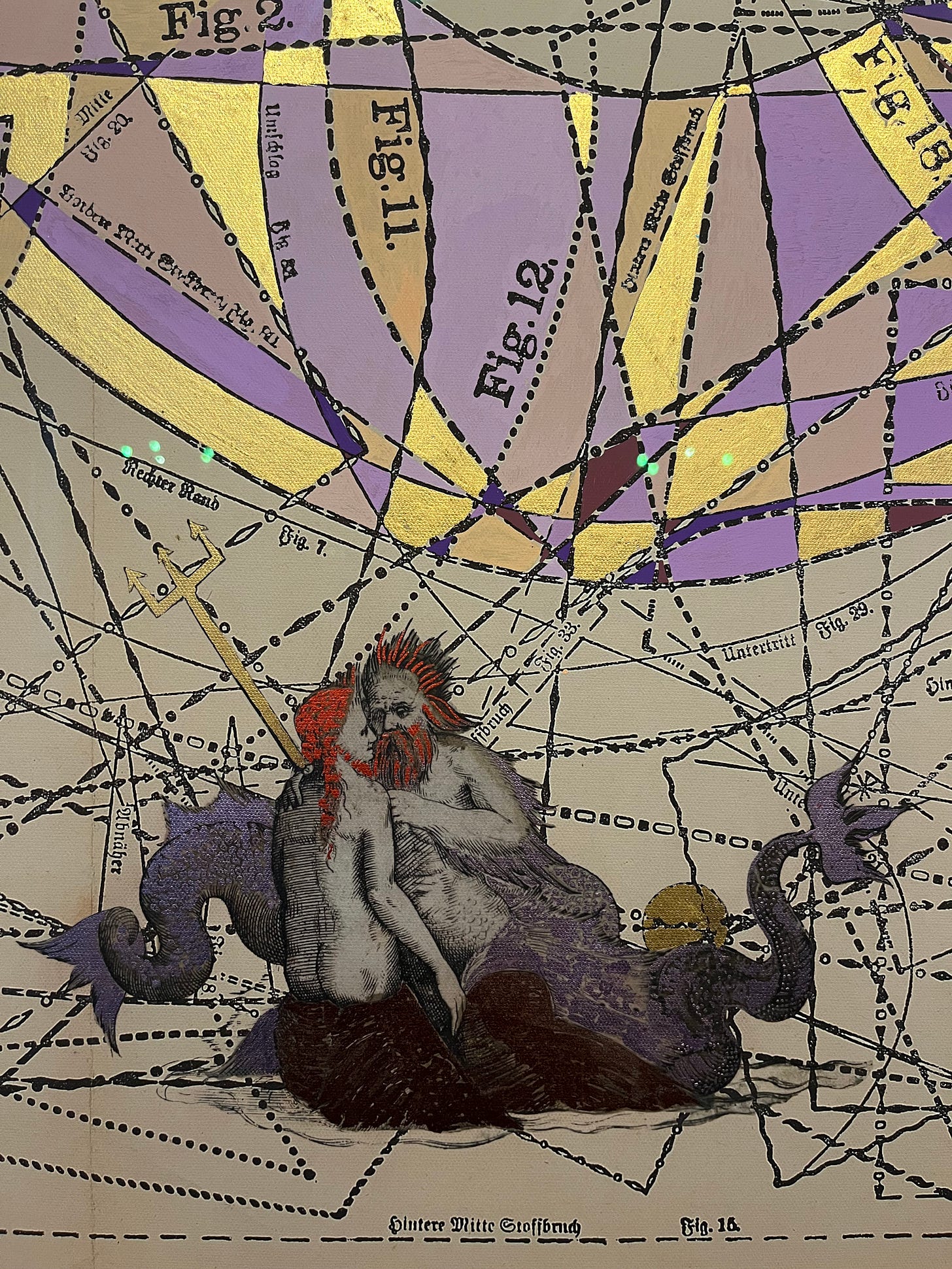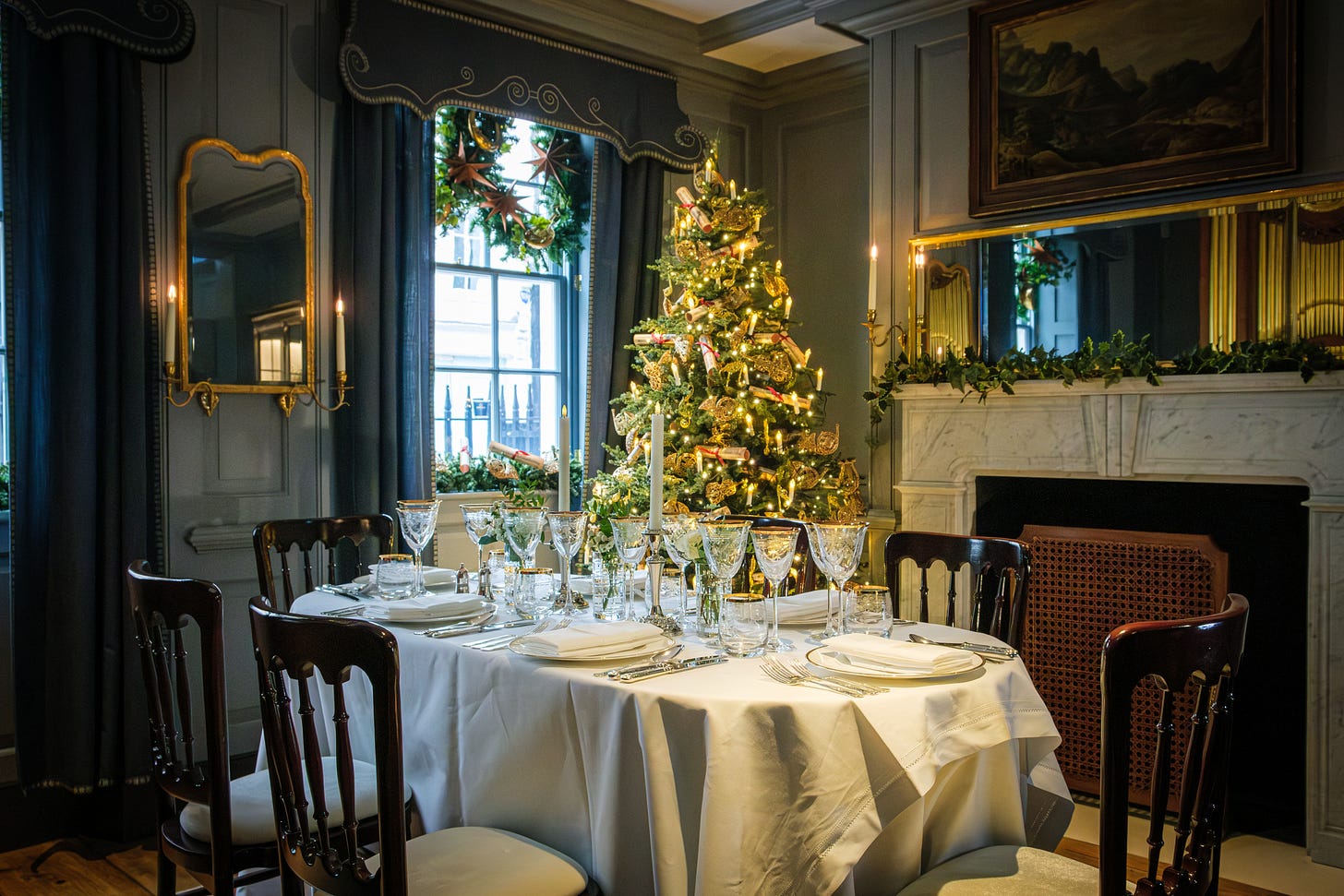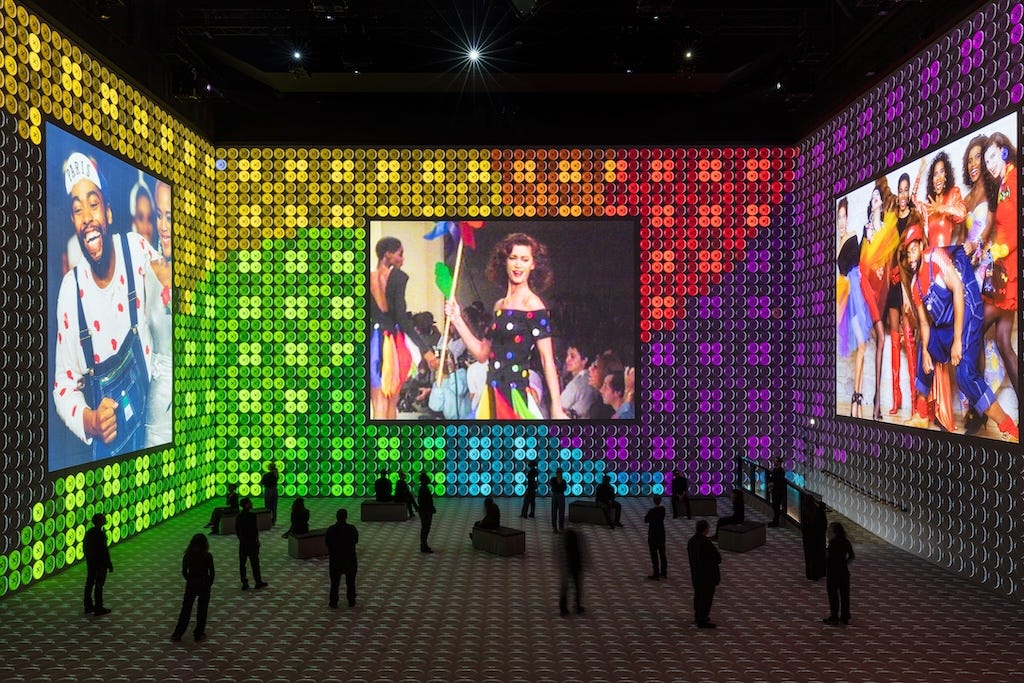Are you not entertained?
Don't worry, I've got what you need
Thanks mostly to the return of the brilliant theatre publication Exeunt (soon to land fully on Substack) and their kind inclusion of TLCE on their reading list, I’ve had a modest flood of new subscribers this week, so welcome to you all.
In celebration, this edition of the Big Thursday Bulletin will be free to read, at least for a bit, so that if you’re new, you can see what’s what, and if you’re just lurking here for free (which is fine, I do that too) you can see what you’d get if you took the plunge.
The long-awaited (is it though? Did anyone ask for it?) Gladiator II is released tomorrow, and honestly the only reason I was interested was Paul Mescal, which at least shows you what a genius bit of casting that was.
Still, I felt a bit sorry for him by the end of this dusty swordfight, because rather like when they cast the brilliant Tom Hardy as Bane in The Dark Knight Rises, and then covered most of his face with what looked like the back end of a washing machine, it appears that Ridley Scott has brought in one of Europe’s most nuanced young actors and then asked him not to act.
To his credit, Mescal has ignored this directive, and remains mesmerisingly watchable whenever he’s on screen, but not without resistance. He has not been given a lot to work with, script-wise, though I would pay good money (rather like the baying Roman populace, or populus) to repeatedly watch the scene where he bites a furious baboon.
Denzel Washington, on the other hand, is a scenery-chewing delight as Macrinus, a former slave who has somehow (ruthlessly) made a colossal fortune and is now spending it on wine, incredible clothes and sponsoring gladiators. He lights up the screen every time he’s on it, which, mercifully, is often.
Hat tip too to the hugely enjoyable Tim McInnerney as the hapless, bon-vivant senator Thraex (named, I think, after a particular type of gladiator, whereas there was in fact a Marcus Nonius Macrinus), and to Joseph Quinn and Fred Hechinger as the twin, Nero-like emperors, Geta and Caracalla (also real, but not in this time period), complete with pasty indoor complexions, a borderline sexual bloodlust and a pet monkey. And of course Pedro Pascal is great, as a conflicted general.
The plot is pleasingly preposterous, though the bit where Mescal’s character is captured and enslaved is embarrassingly derivative of the previous film, and there’s a ludicrous ‘reveal’ moment quite late on, involving a marble bust of the former emperor Marcus Aurelius, that had the whole cinema tittering.
Still, the special effects are fab - a naval battle staged on water in the Colosseum is particularly hilarious; everyone is good in it; the fighting is excellent. It’s just… not thrilling. Which is weird. It’s as if Ridley Scott has made a Ridley Scott film by numbers, and you are never, ever, for one millisecond, surprised.
I’ve hurried past the Royal Geographical Society at Kensington Gore many times on my way to the Royal Albert Hall, but I’ve never been inside. Partly that’s because it’s not technically open to the public, but they are trying to make it more ‘permeable’.
One way that they’re doing this is the commissioning of contemporary art responding to their historic collections, including an astonishing selection of maps.
The Mumbai-born artist Hormazd Narielwalla is the latest, and his glittering multi-part mural, Expanding Universe, is now on display in the Map Room for the next five years. Its basis is the criss-crossing lines of 1930s tailoring patterns - maps of the human body which, overlaid onto the same sheet, resemble astronomical maps, or shipping routes.
Narielwalla takes inspiration from the fanciful depictions of sea monsters that litter ancient maps, often as a way of indicating areas of the sea that are unfamiliar but known to be treacherous. There are weird things here, they say; we’re not sure what but you might encounter some trouble beneath the surface.
The artist is interested in that borderland where fantasy encroaches on the territory of truth - maps are nothing if not a way of dragging the world into some kind of order, whether that is geographical or political.
Narielwalla’s 15-piece work, with its gold and silver planets dotted around, suggesting a sort of fantastical Milky Way, is a lovely thing to see if you find yourself in that area - you could combine it with a trip to see Lauren Halsey’s exhibition at the Serpentine, for example. There’s a tour scheduled on Monday December 11 at 2.00 pm (book a slot by emailing director@rgs.org) and more will be announced.
India is having a moment in the visual arts in London right now. Two major exhibitions devoted to the art of that vast country have opened in the last month, and I saw both in quick succession this week. Both are excellent, in very different ways.
The Great Mughals, at the V&A until May 4, explores the art that developed over the reigns of three Mughal emperors (Akbar, Jahangir and Shah Jahan, who ordered the construction of the Taj Mahal) between about 1580 and 1650. It’s a riot of beauty.
The Mughal emperors were some of the richest and most cosmopolitan on the continent and the art that was created during their reigns is both drenched in a multiplicity of influences and singular to Mughal culture. From exquisitely detailed miniature paintings to jewel-encrusted weaponry, from carpets to wine cups made from jade, from mother-of-pearl ewers to a bewilderingly beautiful hunting coat made of embroidered satin, this is an almost overwhelming display.
I’m an absolute sucker for an ostentatiously jewelled dagger, which perhaps says more about me than I’m entirely comfortable with, but I was in heaven. The miniature paintings, set in lush gardens full of scientifically accurate birds or trees overrun with squirrels, are just glorious.
And there’s an elegance to all this too; lavish and over the top it may be, and yes, if they had taps, it’s true that they probably would have been gold, but they’d have been the most refined, graceful, finely-wrought gold taps you’ve ever seen. I found the whole thing quite bewitching.
The Imaginary Institution of India: Art 1975 to 1998 at the Barbican looks at the work of modern and contemporary artists working between Indira Gandhi’s declaration of a state of emergency in 1975 and the Pokhran nuclear tests in 1998.
It is highly informative, and, I think, quite brave. This is a punchy show, taking as its bookends two events that are little-known in the West, and showcasing the work of Indian artists who have reacted to them and the fraught period between them (marked by social upheaval, economic collapse, and rapid urbanisation), often in protest. Several of them are now banned in their homeland.
It’s a lot. The work, which spans painting, sculpture, film and photography, is often beautiful, but it is also hard-hitting, highlighting hardships and deep injustices that have been meted out to certain groups in India during the chosen period.
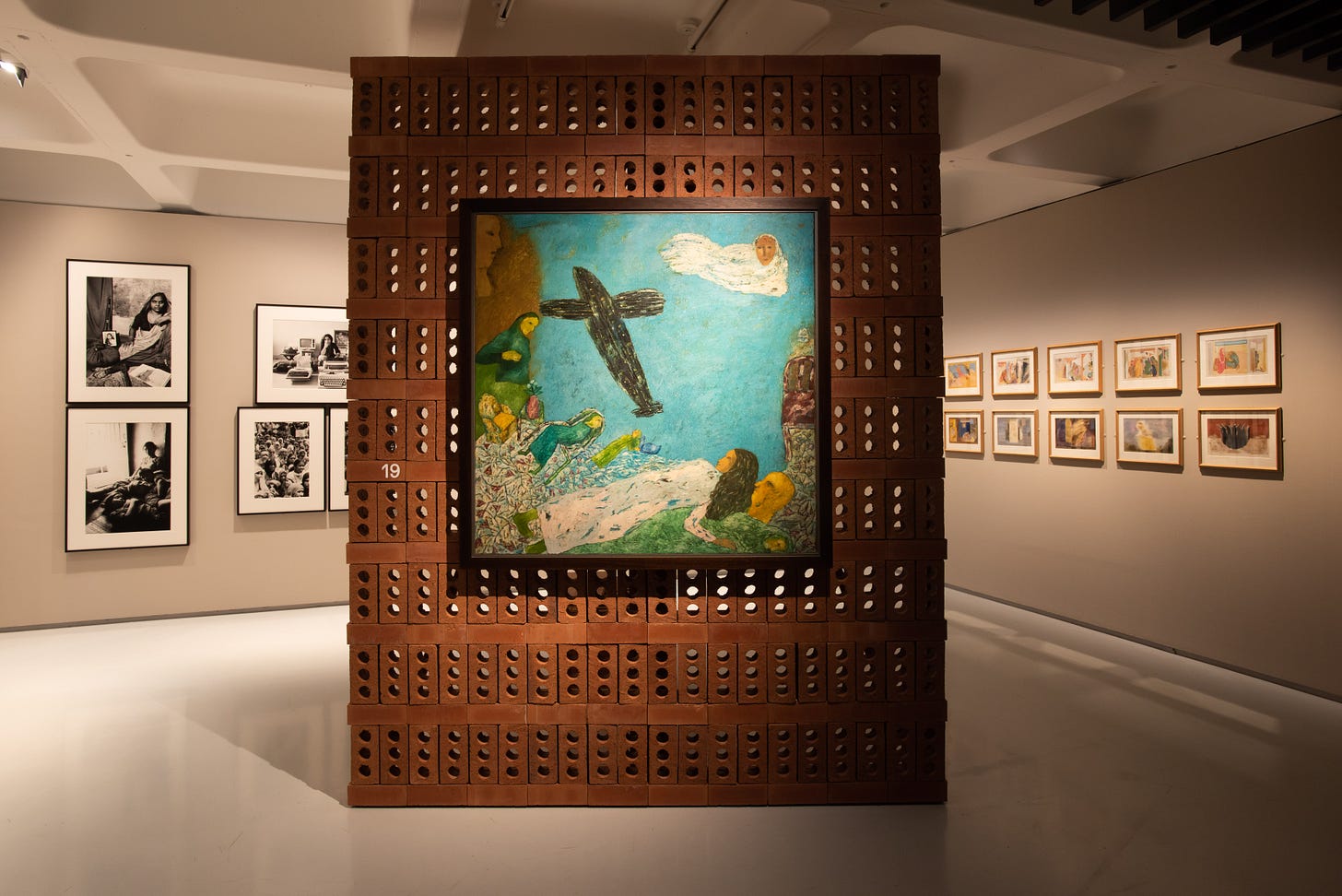
I was struck by, in no particular order, Sudhir Patrwardhan’s packed cityscapes; Sunil Gupta’s photographic portraits of lonely gay men in New Delhi; Nilima Sheikh’s paintings When Champa Grew Up, showing the devastating trajectory of a real young woman from idealistic teenager to murdered wife; Pablo Bartholomew’s grim documentary photographs tracing the results of the 1984 toxic gas leak from the Union Carbide pesticide plant in Bhopal; and Rummana Hussain’s striking installations, which use the shattered terracotta pot as a recurring motif.
There’s loads more. It’s a big show, and it needs a bit of time - allow an hour and a half, though you’ll probably be through quicker unless you’re a very assiduous addresser of pictures. I’m impressed that they’ve done it, and so uncompromisingly. It runs to January 5.
Last night I saw the musical of The Curious Case of Benjamin Button, which did so well at Southwark Playhouse and has just started a limited run at the Ambassador’s Theatre until February 15. My London Theatre Review podcast co-host Nick Clark absolutely adored it, but I was mildly sceptical. Inevitably, I loved it.
They’ve shifted the setting of F. Scott Fitzgerald’s short story to a Cornish fishing village, which works ridiculously well, especially since the sea is a very useful metaphor for pretty much anything.
The criminally under-appreciated Clare Foster and John Dalgliesh - both of whom can really sing and really, really act, Foster being a particularly lively and generous actor - lead a cast of talented and energetic actor-musicians, who roam the stage with their instruments (including, in the case of Anna Fordham, dancing with a double bass) and play all the other characters.
The musicianship and the movement are both extraordinary - though it can sometimes be hard to pick up every line of the lyrics; it’s possible that it would be easier if quite so many people weren’t singing at once, a lot of the time. Overall thought this is a brilliant work of musical theatre and storytelling, and we came out on cloud nine. They’ve got rid of the puppets too, which were apparently a feature before, to which I can only say, thank God.
Also on now
Regular readers will know I’m not the world’s biggest fan of circus, but I will concede that La Clique, who have been treading that tightrope for 20 years this year, do it with style.
They’ve brought together an incredible lineup of people for their anniversary show, to do alarmingly difficult things in sequins, from hand balancers to aerialists, death-defying roller skaters to ‘hair-hangers’ (wince), tap dancers, tension strap performers (not sure), jugglers and cabaret acts, which strikes me as a hoot for a Christmas outing. It’s on now at the Leicester Square Spiegeltent, until January 5.
A bunch of London’s historic house museums are laying on more traditionally festive events this season. Dickens Christmas at the Dickens Museum, will be particularly twinkly, all decked out as it would have been in the Victorian era (v cosy).
Throughout November and December, James Swanton (who played the Mummy in Mark Gatiss’s ghost story adaptation, Lot No. 249, on the BBC last year) performs a selection of Dickens’ Christmas stories live - The Haunted Man, A Christmas Carol and The Chimes - and there are Christmas-themed tours of the house which last about an hour.
The Handel Hendrix House, at 25 Brook Street in Mayfair, will be also opulently dressed for Christmas from November 21 to December 22, with late night openings on Thursdays with mulled wine and cider.
Once (but not at the same time) home to two legendary musicians - George Frideric Handel lived there for more than 30 years until his death in 1759, and Jimi Hendrix made his home in the top-floor flat between 1968 and 1969 - Handel Hendrix House has recently undergone a major refurbishment and restoration, and this winter it’s being tarted up for Christmas.
There’ll also be what they’re describing as an ‘immersive’ display (how? Is there perhaps just music?) about the composition of Handel’s Messiah, performed around the world at Christmas time (because even though it’s written for Easter, any excuse will do), which was written at the House. The Georgian kitchen will be laid out for a feast, there’s live music each weekend, Friday to Sunday, and family crafting inspired by 1960s Christmas decorations.
Incidentally I had no idea that an album of Hendrix playing Christmas music was released posthumously in 1974. I wonder whether he would have been happy about it.
And finally the lovely Museum of the Home in Shoreditch, which is mostly rooms decked out to illustrate domestic life in different time periods, will decorate them in a showcase of festive traditions from 1630 to 2049 in their Winter Past exhibition, running from November 19 to January 12. I wrote about the new rooms, which include a Caribbean-British family’s 1978 sitting room and a 2000s queer flat share, here.
Book now
I idiotically failed to go and see The Moonwalkers: A Journey with Tom Hanks at Lightroom, and it’s just ended. Apparently it was brilliant, and I can just imagine how a multi-part film about space exploration would lend itself to the immersive digital environment the venue provides.
Fortunately it’s coming back, and will be running over the following periods - December 13-15 on its own and from December 19 to January 6 in repertory with their new show, of which more in a mo. It’s in rep again during half-term from February 14-22, and plays weekday mornings and Sundays from March 31 to April 27.
Vogue: Inventing the Runway opened at Lightroom earlier this week and is a treat if you’re remotely interested in fashion. The film (which is what it is really, albeit with some digital bells and whistles) whips through a potted history of the industry and the catwalk show, starting with the 1880’s Parisian atelier of the British-born designer Charles Frederick Worth - the first to show his creations on live models, albeit only to his exceedingly exclusive clientele, rather than to the press or the public.
It then gallivants through history, and some of the greatest names in fashion (Vivienne Westwood, Lee Alexander McQueen, Azzedine Alaïa, Karl Lagerfeld, Coco Chanel, Virgil Abloh etc).
It also includes some whom I didn’t know, notably Patrick Kelly, a young black American designer who made a big noise in Paris in the 1980s with his joyful, poppy designs inspired by the women of his Mississippi childhood, and championed size-inclusiveness in fashion. He died, aged 35, of an AIDS-related illness. I’d like to see a display about him at the Fashion and Textile Museum, or the V&A, say. The show is at Lightroom until April 26.
I’m really looking forward to The Purists, Dan McCabe’s New York-set play that is opening in a couple of weeks at the Kiln theatre. It follows a former rapper, a hip-hop DJ and an old-school Broadway baby as they bicker about musical purity on the stoop of their Queens tenement, before two young women, embarking on a rap battle, challenge their intransigent beliefs about music and identity.
The cast includes Sule Rimi, who was fantastic as the doctor, Sam, in Blues for an Alabama Sky at the National Theatre in 2022. He’s always worth watching, and I love the idea of the play. That’s now in previews, and runs to December 21.
Further ahead
As usual I got to updating my classical music calendar for 2025 a bit late, and found that, inevitably, Lang Lang’s concert at the Barbican on April 17 is already sold out. BUT he’s also playing one there on October 6, which is about half sold at the time of writing, so if you want to see probably the biggest international piano star in the known universe then I suggest you book it because they are going FAST.
I’m not especially interested in the music, but I am intrigued after watching that mad documentary and I have no doubt that Robbie Williams is one hell of a showman - he’s going on tour next year, and will play one London date, at Emirates Stadium on June 6. Tickets go on sale tomorrow, Friday November 15.
In a classic left-field move, a semi-biopic of Williams is being released on December 26, Better Man, with Williams portrayed as a chimp, played by Jonno Davies using motion capture. No idea why.




